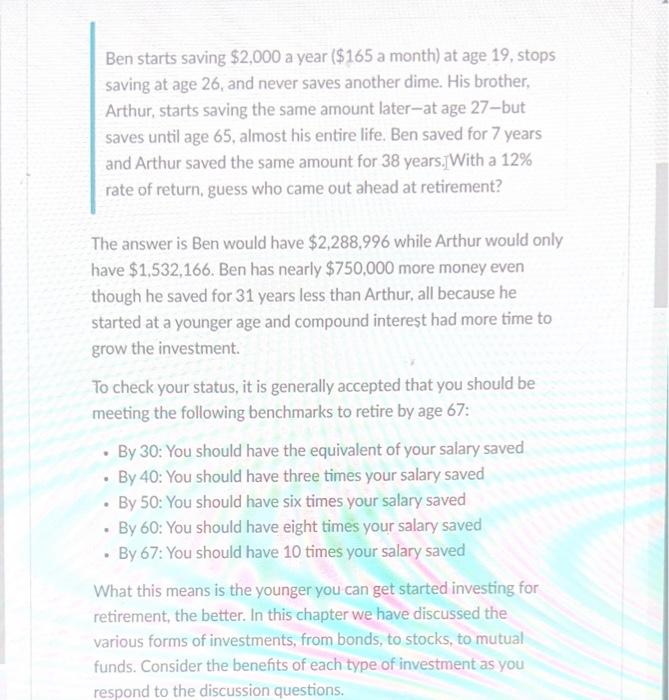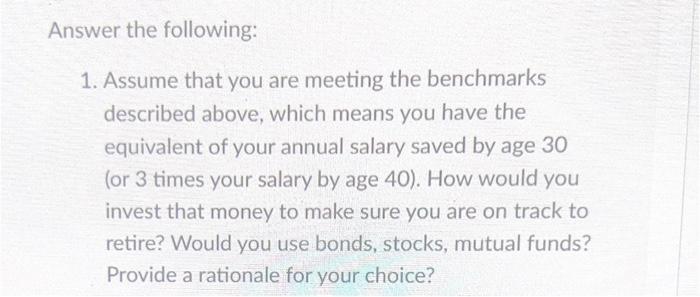Ben starts saving $2,000 a year (\$165 a month) at age 19, stops saving at age 26, and never saves another dime. His brother, Arthur, starts saving the same amount later-at age 27 -but saves until age 65 , almost his entire life. Ben saved for 7 years and Arthur saved the same amount for 38 years. With a 12% rate of return, guess who came out ahead at retirement? The answer is Ben would have $2,288,996 while Arthur would only have $1,532,166. Ben has nearly $750,000 more money even though he saved for 31 years less than Arthur, all because he started at a younger age and compound interest had more time to grow the investment. To check your status, it is generally accepted that you should be meeting the following benchmarks to retire by age 67 : - By 30: You should have the equivalent of your salary saved - By 40: You should have three times your salary saved - By 50: You should have six times your salary saved - By 60: You should have eight times your salary saved - By 67: You should have 10 times your salary saved What this means is the younger you can get started investing for retirement, the better. In this chapter we have discussed the various forms of investments, from bonds, to stocks, to mutual funds. Consider the benefits of each type of investment as you respond to the discussion questions. Answer the following: 1. Assume that you are meeting the benchmarks described above, which means you have the equivalent of your annual salary saved by age 30 (or 3 times your salary by age 40). How would you invest that money to make sure you are on track to retire? Would you use bonds, stocks, mutual funds? Provide a rationale for your choice? Ben starts saving $2,000 a year (\$165 a month) at age 19, stops saving at age 26, and never saves another dime. His brother, Arthur, starts saving the same amount later-at age 27 -but saves until age 65 , almost his entire life. Ben saved for 7 years and Arthur saved the same amount for 38 years. With a 12% rate of return, guess who came out ahead at retirement? The answer is Ben would have $2,288,996 while Arthur would only have $1,532,166. Ben has nearly $750,000 more money even though he saved for 31 years less than Arthur, all because he started at a younger age and compound interest had more time to grow the investment. To check your status, it is generally accepted that you should be meeting the following benchmarks to retire by age 67 : - By 30: You should have the equivalent of your salary saved - By 40: You should have three times your salary saved - By 50: You should have six times your salary saved - By 60: You should have eight times your salary saved - By 67: You should have 10 times your salary saved What this means is the younger you can get started investing for retirement, the better. In this chapter we have discussed the various forms of investments, from bonds, to stocks, to mutual funds. Consider the benefits of each type of investment as you respond to the discussion questions. Answer the following: 1. Assume that you are meeting the benchmarks described above, which means you have the equivalent of your annual salary saved by age 30 (or 3 times your salary by age 40). How would you invest that money to make sure you are on track to retire? Would you use bonds, stocks, mutual funds? Provide a rationale for your choice








